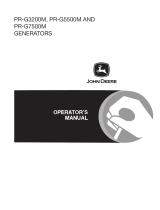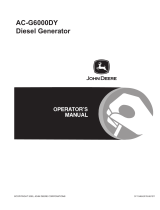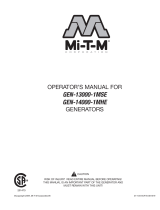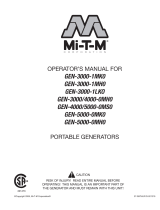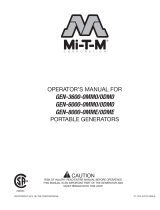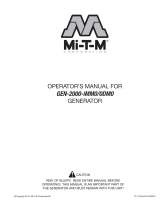Page is loading ...

2 Operator’s Manual
Introduction
THANK YOU for purchasing a John Deere product.
READ THIS MANUAL carefully to learn how to operate
and service your machine correctly. Failure to do so could
result in personal injury or equipment damage. This manual
and safety signs on your machine may also be available in
other languages. (See your John Deere dealer to order.)
THIS MANUAL SHOULD BE CONSIDERED a permanent
part of your machine and should remain with the machine
when you sell it.
MEASUREMENTS in this manual are given in both
metric and customary U.S. unit equivalents. Use only
correct replacement parts and fasteners. Metric and inch
fasteners may require a specic metric or inch wrench.
RIGHT HAND AND LEFT HAND sides are determined by
facing the motor end of the machine.
The SERIAL NUMBER is located in the Specication or
Identication Numbers section. Accurately record all the
numbers to help in tracing the machine should it be stolen.
Your dealer also needs these numbers when you order
parts. File the identication numbers in a secure place
off the machine.
WARRANTY is provided from your John Deere dealer for
customers who operate and maintain their equipment as
described in this manual. The warranty is explained on
the warranty certicate shown in this manual.
This warranty provides you the assurance that your
dealer will back products where defects appear within
the warranty period. Should the equipment be abused,
or modied to change its performance beyond the original
factory specications, the warranty will become void.

Operator’s Manual 3
Contents
Page
Safety ........................................................................ 4
Safety Signs ............................................................. 5
Controls ................................................................. 12
Preparing the Generator ........................................ 13
Operation ................................................................ 17
Troubleshooting ..................................................... 21
Service .................................................................... 22
Storage .................................................................... 27
Specications ......................................................... 28
Accessoires .............................................................. 29
Warranty .............................................................30-32

4 Operator’s Manual
W
A
R
N
I
N
G
W
A
R
N
I
N
G
S
I
N
T
H
E
M
A
N
U
A
L
S
.
W
A
R
N
I
N
G
S
I
N
T
HE
M
A
N
U
A
L
S
.
C
A
U
T
I
O
N
O
C
A
U
T
I
O
N
S
I
N
O
T
H
E
M
A
N
U
A
L
S
O
C
A
U
T
I
O
N
S
I
N
O
T
H
E
M
A
N
U
A
L
S
O
C
A
U
T
I
O
N
S
I
N
O
T
H
E
M
A
N
U
A
L
S
O
C
A
U
T
I
O
N
S
I
N
O
T
H
E
M
A
N
U
A
L
S
Safety
RECOGNIZE SAFETY INFORMATION
This is the safety alert symbol. When you see this symbol
on your machine or in this manual, be alert to the potential
for personal injury.
Follow recommended precautions and safe operating
practices.
UNDERSTAND SIGNAL WORDS
A signal word--DANGER, WARNING or CAUTION--is used
with the safety-alert symbol. DANGER identies the most
serious hazards.
DANGER or WARNING safety signs are located near
specific hazards. General precautions are listed on
CAUTION safety signs. CAUTION also calls attention to
safety messages in this manual.
FOLLOW SAFETY INSTRUCTIONS
Carefully read all safety messages in this manual and
safety signs on your machine. Keep safety signs in good
condition. Replace missing or damaged safety signs.
Be sure new equipment components and repair parts
include the current safety signs. Replacement safety signs
are available from your John Deere Customer Service
Representative.
Learn how to operate the machine and how to use controls
properly. Do not let anyone operate without instruction.
Keep your machine in proper working condition.
Unauthorized modications to the machine may impair the
function and/or safety and affect machine life.
If you do not understand any part of this manual and need
assistance, contact your John Deere Customer Service
Representative.

Operator’s Manual 5
CARBON MONOXIDE - POISONOUS GAS
Use generator outdoors, away from open windows, vents, or
doors.
Generator exhaust contains carbon monoxide - a poisonous
gas that can kill you. You CAN NOT smell or see this gas.
Never use a generator in enclosed or partially-enclosed spaces.
Generators can produce high levels of carbon monoxide very
quickly. When you use a portable generator, remember that you
cannot smell or see carbon monoxide. Even if you can’t smell
exhaust fumes, you may still be exposed to carbon monoxide.
If you start to feel sick, dizzy, or weak while using a generator, get
to fresh air RIGHT AWAY. DO NOT DELAY. The carbon monoxide
from generators can rapidly lead to full incapacitation and death.
If you experience serious symptoms, get medical attention
immediately. Inform medical staff that carbon monoxide poisoning
is suspected. If you experienced symptoms while indoors, have
someone call the re department to determine when it is safe to
re-enter the building.
NEVER operate the generator in an explosive atmosphere, near
combustible materials or where ventilation is not sufcient to carry
away exhaust fumes. Exhaust fumes can cause serious injury
or death.
NEVER use a generator indoors, including in homes, garages,
basements, crawl spaces, and other enclosed or partially-enclosed
areas, even with ventilation. Opening doors and windows or using
fans will not prevent carbon monoxide build-up in the home.
Follow the instructions that come with your generator. Locate the
unit outdoors and away from doors, windows, and vents that could
allow the carbon monoxide gas to come indoors.
ONLY run generator outdoors and away from air intakes.
NEVER run generator inside homes, garages, sheds, or other
semi-enclosed spaces. These spaces can trap poisonous gases
EVEN IF you run a fan or open doors and windows.
If you start to feel sick, dizzy, or weak while using the generator,
shut if off and get fresh air RIGHT AWAY. See a doctor. You may
have carbon monoxide poisoning.
Install battery-operated carbon monoxide alarms or plug-in carbon
monoxide alarms with battery back-up in your home, according to
the manufacturer’s installation instructions. The carbon monoxide
alarms should be certied to the requirements of the latest safety
standards for carbon monoxide alarms. (UL 2034, IAS 6-96, or
CSA 6.19.01).
Test your carbon monoxide alarm frequently and replace dead
batteries.

6 Operator’s Manual
SAFETY WARNING WHEN REFUELING
Gasoline is extremely ammable and its vapors can explode if ignited.
Observe all safety regulations for the safe handling of fuel. Handle
fuel in safety containers. If the container does not have a spout, use a
funnel.
Do not overll the fuel tank, leave room for the fuel to expand.
Do not rell fuel tank while the engine is running. Before refueling
the generator, turn it off and let it cool down. Gasoline spilled on hot
engine parts could ignite.
Fill the tank only on an area of bare ground. While fueling the tank,
keep heat, sparks and open ame away. Carefully clean up any spilled
fuel before starting engine.
Always ll fuel tank in an area with plenty of ventilation to avoid
inhaling dangerous fumes.
NEVER store fuel for your generator in the home. Gasoline, propane,
kerosene, and other ammable liquids should be stored outside of living
areas in properly-labeled, non-glass safety containers. Do not store
them near a fuel-burning appliance, such as a natural gas water heater
in a garage. If the fuel is spilled or the container is not sealed properly,
invisible vapors from the fuel can travel along the ground and can be
ignited by the appliance’s pilot light or by arcs from electric switches in
the appliance.
GROUND FAULT CIRCUIT INTERRUPTER
PROTECTION
These generators are equipped with two GFCI (Ground Fault Circuit
Interrupters) 120V duplex receptacles for protection against the hazards
of electrical shock from defective attachments such as, tools, cords,
and cables.
WARNING: The GFCIs may not function unless the generator
is properly grounded. Follow the correct procedure
specified in the section labeled “GROUNDING
INSTRUCTIONS”
A GFCI is a device that interrupts electricity from either the utility or
generator by means of a special type of circuit breaker if a fault current
ow to the ground occurs.
WARNING: Only the 120V Duplex Receptacles are protected
by the GFCI.
A GFCI can be used only with generators that have the neutral wire
internally bonded to the frame, and the frame properly grounded to the
earth. A GFCI will not work on generators that do not have the neutral
wire bonded to the frame, or on generators which have not been properly
grounded. All John Deere generators have internally bonded ground
wires. A GFCI will not work if the unit is not properly grounded.
A GFCI may be required by OSHA regulations, the National Electric Code
and/or local and federal codes when operating a generator.
For additional protections against shock hazards due to defective
equipment attached to the twist-lock receptacles, consider the use of a
GFCI on each of these receptacles as well.
GFCIs and GFCI protected cord sets and cables may be purchased
from local electrical supply houses.

Operator’s Manual 7
ELECTRICAL HAZARDS
This product must be grounded. If it should malfunction or breakdown,
grounding provides a path of least resistance for electric current to
reduce the risk of electric shock.
DANGER - IMPROPER CONNECTION OF THE EQUIPMENT-
GROUNDING CONDUCTOR CAN RESULT IN A RISK OF
ELECTROCUTION. CHECK WITH A QUALIFIED
ELECTRICIAN OR SERVICE PERSON IF YOU ARE IN
DOUBT AS TO WHETHER THE UNIT IS PROPERLY
GROUNDED.
This generator is equipped with a grounding terminal for your
protection. Always complete the ground path from the generator to an
external ground source as instructed in the section labeled “Grounding
Instructions” in the Preparation section of this manual.
The generator is a potential source of electrical shock if not kept dry.
Keep the generator dry and do not use in rain or wet conditions. To
protect from moisture, operate it on a dry surface under an open,
canopy-like structure. Dry your hands if wet before touching the
generator.
Risk of electric shock if you operate this generator with a faulty GFCI
(Ground Fault Circuit Interrupter). Test GFCI before each use, see
Operations Instructions for further information. If GFCI fails test, DO
NOT use your generator. Contact your John Deere Customer Service
Representative.
Plug appliances directly into the generator. Or, use a heavy duty,
outdoor-rated extension cord that is rated (in watts or amps) at least
equal to the sum of the connected appliance loads. Check that the
entire cord is free of cuts or tears and that the plug has all three prongs,
especially a grounding pin.
NEVER try to power the house wiring by plugging the generator into
a wall outlet, a practice known as “back feeding”. This is an extremely
dangerous practice that presents an electrocution risk to utility workers
and neighbors served by the same utility transformer. It also bypasses
some of the built-in household circuit protection devices.
If you must connect the generator to the house wiring to power
appliances, have a qualied electrician install the appropriate equipment
in accordance with local electrical codes. Or, check with your utility
company to see if it can install an appropriate power transfer switch.
For power outages, permanently installed stationary generators are
better suited for providing backup power to the home. Even a properly
connected portable generator can become overloaded. This may result
in overheating or stressing the generator components, possibly leading
to a generator failure.

8 Operator’s Manual
IMPORTANT SAFETY INSTRUCTIONS
WARNING: To reduce the risk of injury, read this operator’s
manual completely before using. When using this product,
the following basic precautions should always be followed:
1. Read all the instructions before using the product.
2. This product is equipped with a Ground Fault Circuit
Interrupter (GFCI) in the power cord to reduce the risk of
electrical shock. If replacement of the plug or cord is
needed, use only identical replacement parts.
3. Do not allow children or untrained persons to operate the
generator.
4. Do not operate the generator when fatigued or under the
inuence of drugs or chemicals. Stay alert. Watch what
you are doing.
5. Follow the maintenance instructions specied in this
manual.
6. When starting the generator, using recoil starter grip,
be sure that nothing is in a position to be hit by the
operator’s hand or arm.
7. Be sure the switch on electric power tools is in the “OFF”
position before plugging them into the generator.
8. Keep the immediate area free of all bystanders.
9. Be sure each person who operates this generator is
properly instructed in its safe operation.
W
A
R
N
I
N
G
W
A
R
N
I
N
G
S
I
N
T
H
E
M
A
N
U
A
L
S
.
W
A
R
N
I
N
G
S
I
N
T
H
E
M
A
N
U
A
L
S
.
C
A
U
T
I
O
N
O
C
A
U
T
I
O
N
S
I
N
O
T
H
E
M
A
N
U
A
L
S
O
C
A
U
T
I
O
N
S
I
N
O
T
H
E
M
A
N
U
A
L
S
O
C
A
U
T
I
O
N
S
I
N
O
T
H
E
M
A
N
U
A
L
S
O
C
A
U
T
I
O
N
S
I
N
O
T
H
E
M
A
N
U
A
L
S

Operator’s Manual 9
IMPORTANT SAFETY INSTRUCTIONS
10. Do not operate the generator or any electrical tool in any
area where water or similar materials constitute
an electrical hazard to the operator. Do not operate on
wet surfaces, in rain or in snow.
11. Always be sure that the generator is on secure footing so
that it cannot slide or shift around, endangering workers.
12. Avoid contacting the hot exhaust manifold, mufer or
cylinder(s). Keep clear of all rotating parts.
13. Unless the tool or appliance is double insulated, it must
be grounded through a properly grounded receptacle.
(See Preparing the Generator, Grounding Instructions).
Tools and appliances which have 3 prong plugs must
be plugged into extension cords and electrical
receptacles with 3 holes. Before operating any electrical
item, be sure it is in good repair.
14. Follow instructions in this manual when testing Ground
Fault Circuit Interrupter to insure reliable operation.
15. Bewareofusingthisequipmentinconnedspaces.
Conned spaces, without sufcient fresh air ventilation,
can contain dangerous gases. Running gasoline engines
in such environments can lead to deadly explosions and/
or asphyxiation.
16. If your generator comes equipped with a transport
dolly, make sure this unit is secure during operation and
when transporting to prevent unexpected movement or
rolling.
17. Use extreme caution when lifting this generator. Do not
use dolly handles to lift this generator, use only
designated lifting hook to lift this generator. This
generator is heavy so proper lifting techniques should be
used.
SAVE THESE INSTRUCTIONS
W
A
R
N
I
N
G
W
A
R
N
I
N
G
S
I
N
T
H
E
M
A
N
U
A
L
S
.
W
A
R
N
I
N
G
S
I
N
T
H
E
M
A
N
U
A
L
S
.
C
A
U
T
I
O
N
O
C
A
U
T
I
O
N
S
I
N
O
T
H
E
M
A
N
U
A
L
S
O
C
A
U
T
I
O
N
S
I
N
O
T
H
E
M
A
N
U
A
L
S
O
C
A
U
T
I
O
N
S
I
N
O
T
H
E
M
A
N
U
A
L
S
O
C
A
U
T
I
O
N
S
I
N
O
T
H
E
M
A
N
U
A
L
S

10 Operator’s Manual
WEAR PROTECTIVE CLOTHING
Wear close fitting clothing and safety equipment
appropriate to the job.
Wear a suitable hearing protective device such as
earmuffs or earplugs to protect against objectionable or
uncomfortable loud noises.
Operating equipment safely requires the full attention of
the operator. Do not wear radio or music headphones while
operating machine.
INSPECT GENERATOR
Be sure all covers, guards and shields are tight and in
place.
Locate all operating controls and safety labels.
Inspect power cord for damage before using. There is a
hazard of electrical shock from crushing, cutting or heat
damage.
PREPARE FOR EMERGENCIES
Keep a rst aid kit and re extinguisher handy.
Keep emergency numbers for doctors, ambulance service,
hospital and re department near your telephone.
Be prepared if a re starts.
SERVICE GENERATOR SAFELY
Before servicing the generator, disconnect all equipment and
battery (if equipped) and allow unit to cool down.
Service generator in a clean dry at area.

12 Operator’s Manual
Controls
CONTROLS FOR AC-G3010H. AC-G4010S, AC-G4010H, AC-G5010S
A -- Control Panel
B -- Fuel Tank
C -- Fuel Cap
D-- Oil Dipstick
D
B
C
A
D
B
C
A
D
B
C
A
E
E -- Oil Drain
E
E

Operator’s Manual 13
GROUNDING INSTRUCTIONS
This product must be grounded. If it should malfunction or
breakdown, grounding provides a path of least resistance for
electric current to reduce the risk of electric shock.
DANGER - IMPROPER CONNECTION OF THE
EQUIPMENT-GROUNDING CONDUCTOR CAN
RESULT IN A RISK OF ELECTROCUTION.
CHECK WITH A QUALIFIED ELECTRICIAN OR
SERVICE PERSON IF YOU ARE IN DOUBT AS
TO WHETHER THE UNIT IS PROPERLY
GROUNDED.
The wing nut and ground terminal on the frame must always
be used to connect the generator to a suitable ground source.
The ground path should be made with #8 size wire. Connect the
terminal of the ground wire between the two star washers and
wing nut then tighten the wing nut fully. Connect the other end
of the wire securely to a suitable ground source.
The National Electric Code contains several practical ways in
which to establish a good ground source. Examples given below
illustrate a few of the ways in which a good ground source may
be established.
A metal underground water pipe in direct contact with the earth
for at least 10 feet can be used as a grounding source. If an pipe
is unavailable, an 8 foot length of pipe or rod may be used as the
ground source. The pipe should be 3/4 inch trade size or larger
and the outer surface must be noncorrosive. If a steel or iron rod
is used it should be at least 5/8 inch diameter and if a nonferrous
rod is used it should be at least 1/2 inch diameter and be listed
as material for grounding. Drive the rod or pipe to a depth of 8
feet. If a rock bottom is encountered less than 4 feet down, bury
the rod or pipe in a trench. All electrical tools and appliances
operated from this generator, must be properly grounded by use
of a third wire or be “Double Insulated”.
It is recommended to:
1. Use electrical devices with 3 prong power cords.
2. Use an extension cord with a 3 hole receptacle and a 3
prong plug at the opposite ends to ensure continuity of
the ground protection from the generator to appliance.
We strongly recommend that all applicable federal, state and
local regulations relating to grounding specications be checked
and followed.
Preparing the Generator
LINE TRANSFER SWITCH
If this generator is used for standby service, it must have
a transfer switch between the utility power service and the
generator. The transfer switch not only prevents the utility
power form feeding into the generator, but is also prevents the
generator form feeding out into the utility company’s lines. This
is intended to protect the serviceman who may be working on
a damaged line.
THIS INSTALLATION MUST BE DONE BY A LICENSED
ELECTRICIAN AND ALL LOCAL CODES MUST BE
FOLLOWED.
GND
34-0889
062104-ENG.

14 Operator’s Manual
ENGINE OIL
Use oil viscosity based on the expected air temperature
range during the period between oil changes.
Use a high quality detergent oil with API classications of
SJ or higher.
Check oil level before each operation and ensure that it
is maintained.
CAUTION: THIS ENGINE CRANKCASE IS NOT
FILLED WITH OIL AT THE FACTORY, SO BE
SURE TO FILL IT BEFORE OPERATING THE
ENGINE.
ENGINE OIL CAPACITY
NOTE:
To ll with oil:
1. Level the engine to ensure accurate inspection and
to prevent overlling.
2. Unscrew the oil gauge (Fig. 1), wipe the dipstick dry.
Reinsert the oil gauge back into the oil ll gauge opening.
Remove the oil gauge and check the oil level.
3. The oil level should be between the full and low marks
on the dipstick. (Fig. 2)
NOTE:
4. Fill with oil as required through the oil ll gauge
opening.
5. Replace the oil gauge and screw in rmly.
6. Wipe up any spilled oil.
(Fig. 1)
(Fig. 2)
OIL GAUGE
UPPER LEVEL
TEMPERATURE CHART
MODEL # Liters Quart Ounces
AC-G3010H 0.6 0.63 20.3
AC-G4010S 0.6 0.63 20.3
AC-G4010H 1.1 1.16 37.2
AC-G5010S 1.1 1.16 37.2

Operator’s Manual 15
FUELING
WARNING: EXPLOSIVE FUEL!
GASOLINE IS EXTREMELY FLAMMABLE
AND ITS VAPORS CAN EXPLODE IF
IGNITED.
STORE GASOLINE ONLY IN APPROVED
CONTAINERS, IN WELL VENTILATED,
UNOCCUPIED BUILDINGS AND AWAY
FROM SPARKS OR FLAMES.
DO NOT FILL THE FUEL TANK WHILE THE
ENGINE IS HOT OR RUNNING, SINCE
SPILLED FUEL COULD IGNITE IF IT
COMES IN CONTACT WITH HOT PARTS OR
SPARKS FROM IGNITION. DO NOT START
THE ENGINE NEAR SPILLED FUEL.
NEVER USE GASOLINE AS A CLEANING
AGENT.
WARNING: DO NOT OVERFILL THE FUEL TANK,
LEAVE ROOM FOR THE FUEL TO EXPAND.
General Recommendations
• Purchase gasoline in small quantities and store in clean,
approved containers.
• To minimize gum deposits in your fuel system and to
insure easy starting, do not use gasoline left over from
the previous season.
• Do not add oil to the gasoline.
Fuel Type
• For best results use only clean, fresh, unleaded gasoline
with a pump sticker octane rating of 87 or higher.
• Unleaded gasoline is recommended as it leaves less
combustion chamber deposits.
GASOLINE/ALCOHOL BLENDS:
Gasohol (up to 10% ethyl alcohol, 90% unleaded gasoline
by volume) is approved, as a fuel. Other gasoline/alcohol
blends are not approved.
GASOLINE/ETHER BLENDS:
Methyl Tertiary Butyl Ether (MTBE) and unleaded gasoline
blends (up to a maximum of 15% MTBE by volume) are
approved as a fuel. Other gasoline/ether blends are not
approved.

16 Operator’s Manual
HIGH ALTITUDE
At high altitude, the standard carburetor air/fuel mixture will
be too rich. Performance will decrease, and fuel consumption
will increase. A very rich mixture will also foul the spark plug
and cause hard starting. Operation at an altitude that differs
from that at which this engine was certied, for extended
periods of time, may increase emissions.
High altitude performance can be improved by specific
modications to the carburetor. If you always operate your
generator at altitudes above 5,000 feet (1,500 meters),
have your dealer perform this carburetor modication. This
engine, when operated at high altitude with the carburetor
modications for high altitude use, will meet each emission
standard throughout its useful life.
Even with carburetor modification, engine horsepower
will decrease about 3.5% for each 1,000-foot (300-meter)
increase in altitude. The effect of altitude on horsepower will
be greater than this if no carburetor modication is made.
NOTE:

Operator’s Manual 17
OPERATION
Recoil Start
NOTE:
1. Open fuel valve on fuel tank. (See Fig. 3)
2. Move choke lever to full choke. If re-starting a warm
engine, the choke should be left in the off position. (See
Fig. 4)
3. Turn the engine ignition switch to the ON position.
4. Pull recoil to start engine.
5. Once engine has started, slowly move choke lever to no
choke.
NOTE:
6. Allow the unit to run for two (2) minute warm-up.
7. Make sure the generator is grounded. See Preparing the
Generator; Grounding Instructions.
8. Test the GFCI receptacle(s) on the unit. Push the test button.
The reset button should pop out and there should be no
power at the receptacle. Apply a test load or lamp to each
receptacle to verify. IF THE RESET BUTTON DOES NOT
POP OUT, DO NOT USE THE RECEPTACLES(S). SEE
DEALER FOR SERVICE IMMEDIATELY.
9. If GFCI receptacle(s) test correctly, rmly push the reset
button to restore power. A distinctive click should be
heard or felt when this is complete. IF THE
RECEPTACLE(S) DO NOT RESET PROPERLY, DO
NOT USE THE RECEPTACLE(S). SEE DEALER FOR
SERVICE IMMEDIATELY.
10. Loads can now be applied to the unit.
11. If unit is equipped with a Full Power Switch, move the
Full Power Switch to the 120V position to direct all power
to the 120V/30A receptacle on the unit. This
will disable all other receptacles.
When the Full Power Switch is in the 120V/240V
position, all receptacles are usable except the 120V/30A
receptacle.
NOTE:
Operation
(Fig. 4)
(Subaru Shown)
(Fig. 3)

18 Operator’s Manual
SHUTDOWN
1. Remove all load by turning off electrical appliances and
unplugging electric cords.
2. Allow engine to run at idle speed or at no load condition to
cool for two (2) minutes.
NOTE:
3. Turn engine key or ignition switch off.
4. Close fuel valve on unit or engine.
CONTROLS
CONTROL PANEL:
The generators are equipped with the following items:
- Circuit Breaker
- One 125 Volt, 20 Amp, GFCI protected receptacles.
- Full Power Switch
- Circuit Breakers
- Two 125 Volt, 20 Amp, Duplex (2 outlets), GFCI protected
receptacles.
- One 125 Volt, 30 Amp, Locking Type Receptacle.
- One 125/250 Volt, 20 Amp, Locking Type Receptacle.
NOTE:
WARNING: NEVER EXCEED THE RATING OF A
RECEPTACLE. These receptacles are
protected against overloads by resetting
magnetic type circuit breakers. If a circuit
breaker trips, the cause should be determined
and corrected prior to continuing use.

Operator’s Manual 19
CONTROLS
OIL WARNING DEVICE:
NOTE:
Check the engine oil before restarting the engine. If the unit is tilted,
level the engine, then check the oil before restarting the engine.
FULL POWER SWITCH:
The Full Power Switch allows the unit to suppy power directly to the 120V-
30A receptacle on the unit. This will disable all other receptacles.
When the Full Power Switch is in the 120V/240V position, all receptacles
are usable except the 120V-30A receptacle.

20 Operator’s Manual
CURRENT LOAD IN WATTS MAXIMUM CABLE LENGTH (FEET)
IN AMPS 120 VOLTS 240 VOLTS #8 WIRE #10 WIRE #12 WIRE #14 WIRE #16 WIRE
2.5 300 600 1000 600 375 250
5 600 1200 500 300 200 125
7.5 900 1800 350 200 125 100
10 1200 2400 250 150 100 50
15 1800 3600 150 100 65
20 2400 4800 175 125 75 50
25 3000 6000 150 100 60
30 3600 7200 125 65
40 4800 9600 90
CONTROLS
CABLE SIZE:
Equipment damage can result from low voltage. Therefore, to prevent
excessive voltage drop between the generator and the equipment,
the cable should be of adequate gauge for the length used. The cable
selection chart gives the maximum cable lengths for various gauges of
wire which can adequately carry the loads shown.
ELECTRIC MOTOR LOADS:
It is characteristic of common electric motors in normal operation to draw
up to six times their running current while starting. This table may be
used to estimate the watts required to start “CODE G” electric motors.
CAUTION: IF AN ELECTRIC MOTOR FAILS TO START OR
REACH RUNNING SPEED, TURN OFF THE
APPLIANCE OR TOOL IMMEDIATELY TO AVOID
EQUIPMENT DAMAGE. ALWAYS CHECK THE
REQUIREMENTS OF THE TOOL OR APPLIANCE
BEING USED COMPARED TO THE RATED OUTPUT
OF THE GENERATOR.
WATTS REQUIRED TO START MOTOR
MOTOR (H.P.) RUNNING WATTS REPULSION INDUCTION CAPACITOR SPLIT PHASE
1/8 275 600 850 1200
1/6 275 600 850 2050
1/4 400 850 1050 2400
1/3 450 975 1350 2700
1/2 600 1300 1800 3600
3/4 850 1900 2600
1 1100 2500 3300

Operator’s Manual 21
Symptom Problem Solution
Engine will not start. Engine switch is off. Turn engine switch to the ON position.
Fuel Tank empty. Fill tank per instructions in this manual.
Fuel Valve is off. Turn Fuel Valve on.
Inadequate engine oil. Check oil level. This engine is
equipped with a low oil sensor. The
engine cannot be started unless the oil
level is above the prescribed lower
limit.
No spark at spark plug. Remove the spark plug cap. Clean any
dirt from around the plug base, then
remove the spark plug. Install the
spark plug in the plug cap. Turn the
engine switch on.
Grounding the electrode to any engine
ground, pull the recoil starter to see if
sparks jump across the gap. If there is
no spark, replace the plug.
Reinstall the plug and start engine
according to instructions in this
manual.
Consult John Deere Customer
Service.
Generator has no output. Circuit breakers tripped. Reset circuit breakers.
Inadequate cord sets or Check cord sets or extension cords
extension cords. capabilities in section Controls;
Cable Size in this manual.
Consult John Deere Customer
Service.
Troubleshooting

22 Operator’s Manual
MAINTENANCE
Keep all air vents clear.
Keep the generator clean. DO NOT spray with water.
Periodically check all fasteners and tighten, see the periodic maintenance chart.
GFCI TEST RECORDS:
As with any other safety devices, the GFCIs supplied with these generators must be checked every month to insure that
they are functioning properly. To test the GFCIs, follow the instructions and then enter the date of the test below.
1. With the generator running and the idle control switch in the “START” position, push the “TEST” button. The
“RESET” button should pop out. This should result in the power being off at both outlets of the duplex receptacle.
Verify this by plugging a test lamp into each outlet.
WARNING: IF THE RESET BUTTON DOES NOT POP OUT, DO NOT USE THE RECEPTACLE(S). SEE
AUTHORIZED John Deere CUSTOMER SERVICE REPRESENTATIVE FOR SERVICE IMMEDIATELY.
2. If the GFCI test correctly, restore power by FIRMLY pushing the “RESET” button back in until you hear or feel a
distinctive “click”. IF THE GFCI FAILS TO RESET PROPERLY, DO NOT USE EITHER OUTLET OF THE DUPLEX
RECEPTACLE. Have the unit serviced by an authorized John Deere Customer Service Representative immediately.
3. High vibration or severe mechanical shock loads may cause the GFCIs to trip. IF EITHER GFCI TRIPS BY
ITSELF AT ANY TIME, reset it and perform test procedures 1 and 2.
4. Repeat steps 1-3 for the second GFCI.
WARNING: ALTHOUGH THE ABOVE TEST PROCEDURES WILL INDICATE PROPER GFCI OPERATION ON
AN UNGROUNDED OR IMPROPERLY GROUNDED GENERATOR, THE GENERATOR MUST STILL
BE GROUNDED PER THE GROUNDING INSTRUCTIONS LISTED ON PAGE 16 FOR THE GFCI TO
FUNCTION PROPERLY AND PROTECT THE USER FROM ELECTRICAL FAULTS.
Service
Year Jan. Feb. March April May June July Aug. Sept. Oct. Nov. Dec.
NOTE:
/
